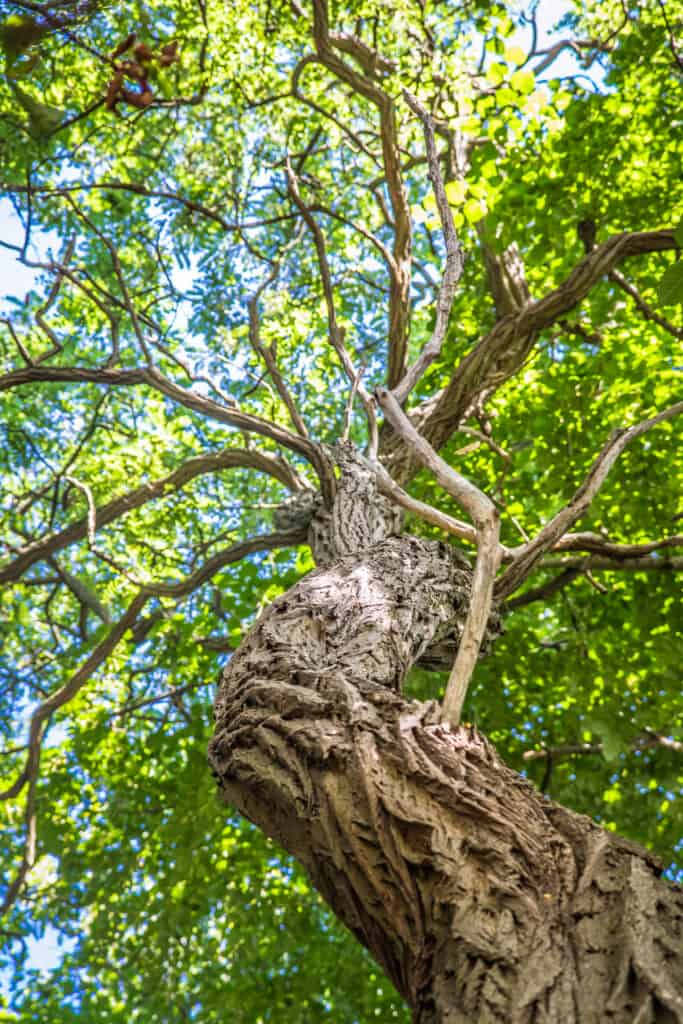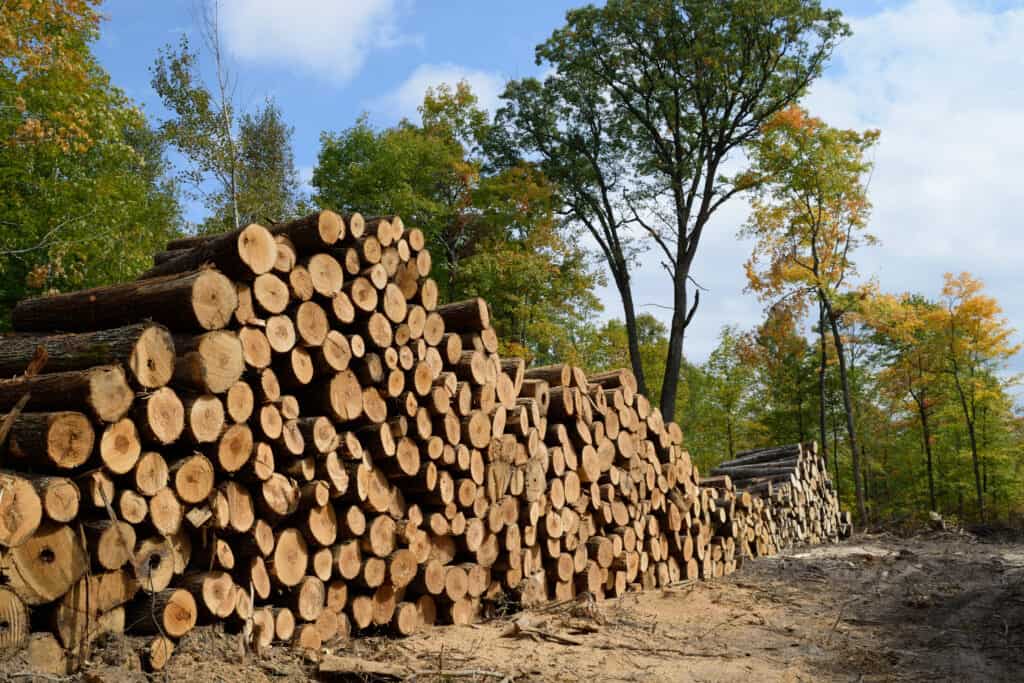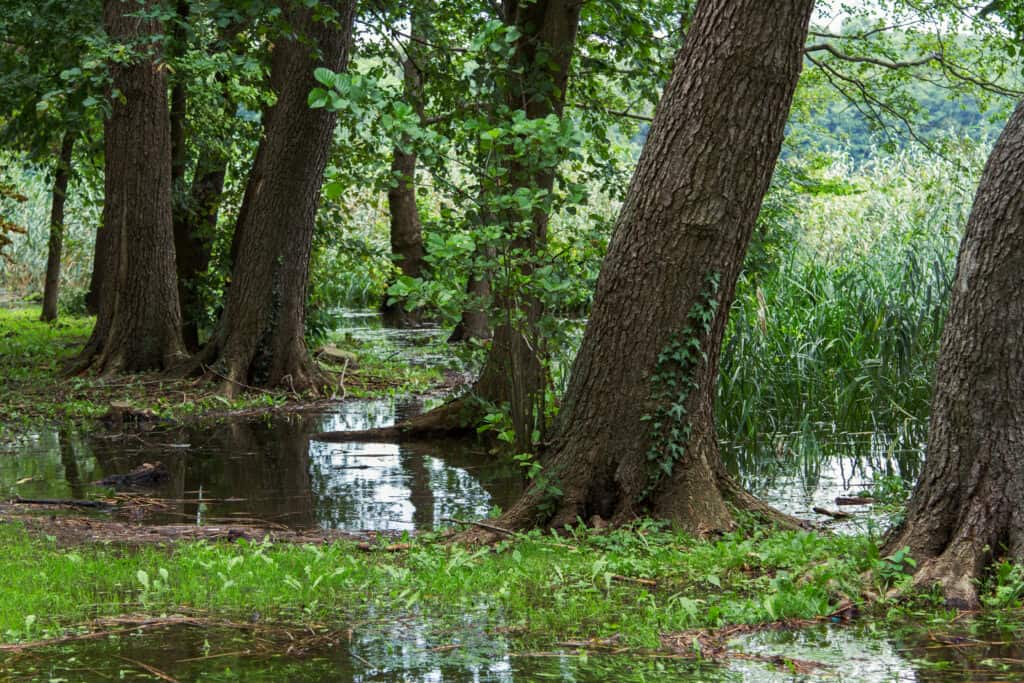The basswood tree and alder wood tree are common trees found around North America. These two beauties are usually used for lumber and construction, though they both make excellent landscaping trees as well.
Not sure which tree fits your specific need? In this guide, we’ll explore the details about both the basswood tree and the alder tree, so you can make the right choice for your yard or woodworking project.
Comparing Basswood vs. Alder Wood
| Basswood | Alder Wood | |
|---|---|---|
| Classification | Tilia americana | Alnus glutinosa |
| Alternative Names | American basswood, American linden, lime trees | common alder, black alder, European alder |
| Origin | New England, North America | Europe |
| Description | A wide-set tree that can grow over 80 feet tall and boasts circular leaves. | A dark-hued tree covered in a type of lichen that grows in a cone-like shape. |
| Uses | Wood is used as a versatile construction material. Also used in landscaping and as an ornamental tree. | Wood is used for furniture and musical instruments. Also used in landscaping. |
| Growth Tips | Always plant in moist soil where saplings can receive either full sun or just partial shade. | Plant in damp, clay-based soil and water regularly during drought periods every other week. |
| Interesting Features | The wood from this tree is used to make musical instruments, building materials, and statues. | The wood from this tree is used to make musical instruments, as well as cabinetry and furniture material. |
The Key Differences Between Basswood and Alder Wood
These two trees are similar in that they can easily reach over 100 feet in height. They are also both used for their lumber for manufacturing everything from building materials to furniture to musical instruments. The basswood and alder wood trees do have some differences worth knowing.
The basswood tree can grow in USDA Hardiness Zones 2 – 8. The alder wood tree has more limiting requirements and grows in USDA Hardiness Zones 3 – 7. As such, the basswood tree would be considered hardier than the alder tree. There is also a difference in origin. The American basswood is native to North America, while the alder tree is native to Europe. This likely is the cause behind the alder tree’s inferior hardiness.
The basswood tree is also notably more difficult to grow than the alder tree. The seeds of these trees are very difficult to propagate with a viability rate of about 30%. The alder tree, alternatively, is fairly easy to grow provided it is in the ideal climate.

The American basswood is native to North America compared to alder trees which originated in Europe.
©iStock.com/LeManna
Basswood vs. Alder Wood: Classification
The American basswood tree is classified as Tilia americana. Its genus Tilia contains 30 different species of trees and bushes, including the Japanese lime, Oliver’s lime, and silver linden.
The alder wood tree is classified as Alnus glutinosa. The genus Alnus contains 35 species of trees and shrubs classified as birches, which include the Italian alder, Arizona alder, and white alder.
Basswood vs. Alder Wood: Description
The American basswood is a medium to large-sized deciduous tree that may grow as high as 128 feet, however, it usually reaches its maximum height at 80 feet. At maturity, the basswood has a trunk diameter of three to five feet. It develops more quickly than many North American hardwoods, frequently doubling the yearly growth rate of numerous birch species including American beech. The average lifespan of an organism is 200 years, and while occasionally seed production may begin as early as eight years, flowering and seeding typically take place between 15 and 100 years after the organism is born.
The alder tree is a kind of tree that grows best in moist soils and can reach about 100 feet in height in the right conditions. Older trees produce an arching crown with crooked branches instead of the upright growth habit and main axial stem that young trees have. The adventitious roots that form at the base of the trunk spread out into the ground and may appear to be supporting the trunk. Young alder trees have smooth, glossy, greenish-brown bark, whereas elderly trees have a dark grey, fissured bark.

Older alder trees produce an arching crown with crooked branches instead of the upright growth habit of young trees.
©Aleksandra Duda/Shutterstock.com
Basswood vs. Alder Wood: Uses
Both the basswood and alder wood trees are used as landscaping trees. When dense foliage or a deep shade is sought, the American basswood is suggested as an ornamental tree for landscaping. In order to shield young, vulnerable trees, it is frequently planted on the windward side of an orchard.
The common alder is utilized as a pioneer plant to stabilize riverbanks, help with flood control, filter water in soils that have been inundated with water, and moderate water body temperature and nutrient status. It can be cultivated on its own or in plantations with other species, and the nitrogen-rich leaves that fall to the ground improve the soil and boost the growth of other tree species on subpar soils.
Perhaps the most common use of either the basswood or alder wood trees is for lumber. Basswood is a light shade of brown, occasionally almost white or subtly reddish. It has a low steam-bending classification and low strength. It planes, glues, screws, and nails well, and it takes stains without issue. This makes it valuable for the production of wooden goods, affordable furniture, and carriage bodies. It is also particularly suited for wood carving. The inner bark is extremely dense and durable; historically, ropes have been made from it. It is a popular wood for use in the construction of solid-body electric guitars because it is light, sturdy, and resonant. However, because it lacks noticeable grain, it is an unattractive candidate for transparent finishes and is typically used for guitars that will be painted opaque colors.
In the building business, alder wood is not employed where strength is necessary, but it is used in the manufacturing of paper, fiberboard, and energy. Because it is so strong underwater, wood is employed for deep building foundations. The wood is used in joinery, where its texture and color are valued as well as how well it takes dye, both as solid wood and as veneer. The wood may be easily worked and split because it is supple, flexible, and rather light. It is used to make furniture, window frames, clogs, toys, blocks, pencils, and bowls. It is also prized in turnery and carving. Some musical instruments are made from alder wood as well.

Basswood (Tilia americana) lumber often used in construction.
©ClubhouseArts/Shutterstock.com
Basswood vs. Alder Wood: Origin
The basswood tree is indigenous to eastern North America, from southeast Manitoba to northeast Oklahoma, southeast to South Carolina, and west along the Niobrara River to Cherry County, Nebraska. It is also found in the southwestern United States and southern Canada. In the Western Hemisphere, it is the only member of its genus.
Most of Europe, southwest Asia, and northern Africa are home to the alder tree. It thrives in moist environments where it may grow in subpar soils thanks to its relationship with the bacterium Frankia alni. It has been introduced, either accidentally or on purpose, to Chile, South Africa, Australia, and New Zealand, as well as Canada and the United States.

Alder trees can be used to stabilize riverbanks, help with flood control, filter water in soils, and moderate water temperature and nutrient status.
©Ihor Hvozdetskyi/Shutterstock.com
Basswood vs. Alder Wood: How to Grow
As mentioned earlier in this guide, basswood is difficult to grow from seed, so try to seek out a sapling instead. Basswood trees do well in clay, loamy, or sandy soils, but they prefer moist soil. They appear unaffected by soil acidity and can thrive in a variety of conditions, from extremely acidic to extremely alkaline soils. Basswood trees should be planted where they will receive full sun to partial shade.
Alder grows quickly and easily. If the seed is lightly covered with dirt and grown in flats during the winter, it will germinate in the spring. Alder may grow in a variety of soil types, from hard clay to medium loamy soil. It can withstand maritime conditions well. Although it may also grow in nutrient-poor soil, it prefers a pH of greater than six.
Basswood vs. Alder Wood: Special Features
Consider growing a basswood tree if your yard is expansive and has enough space for a medium to large tree to extend its limbs. These attractive trees have a loose canopy that creates a dappled shadow on the ground below and just enough sunlight for the grasses and flowers that grow in the shade to flourish. Basswood trees are simple to grow since, once they’re established, they require little maintenance.
Alder trees are frequently employed in reforestation initiatives and to help the soil retain moisture in damp locations, but you hardly ever see them in private landscaping. When available, these attractive plants make great shade trees and screening shrubs, but home gardener-focused nurseries rarely sell them.
Either one of these trees is excellent and hardy. If you want to grow a basswood or alder tree for wood, both would be excellent for various use cases, especially for building musical instruments. Either one is also great for landscaping as well.
Up Next
- Basswood vs Mahogany: What’s the Difference?
- The Largest Trees In California
- Coconut Tree vs Palm Tree: 5 Key Differences
The photo featured at the top of this post is © Ihor Hvozdetskyi/Shutterstock.com
Sources
- Lady Bird Johnson Wildflower Center / Accessed November 15, 2022
- Gardening Know How / Accessed November 15, 2022
FAQs (Frequently Asked Questions)
What is basswood and alder wood used for?
Both of these trees are used as ornamental plants. Their bark is also used for construction, particularly for building guitars and other musical instruments.
Do basswood trees do well in urban environments?
Yes, basswood does well in urban environments and is often used for landscaping in suburbs.
Are alder trees good for shade?
Alder trees offer excellent shade and are often used as screening trees in landscaping.
Thank you for reading! Have some feedback for us? Contact the AZ Animals editorial team.







